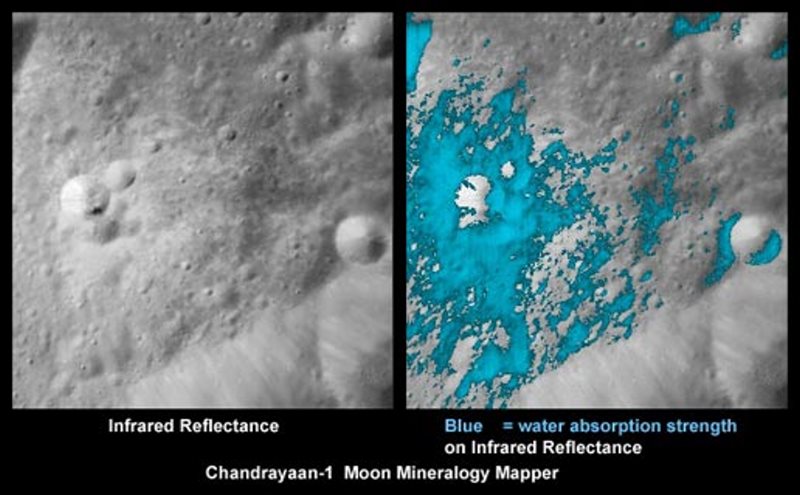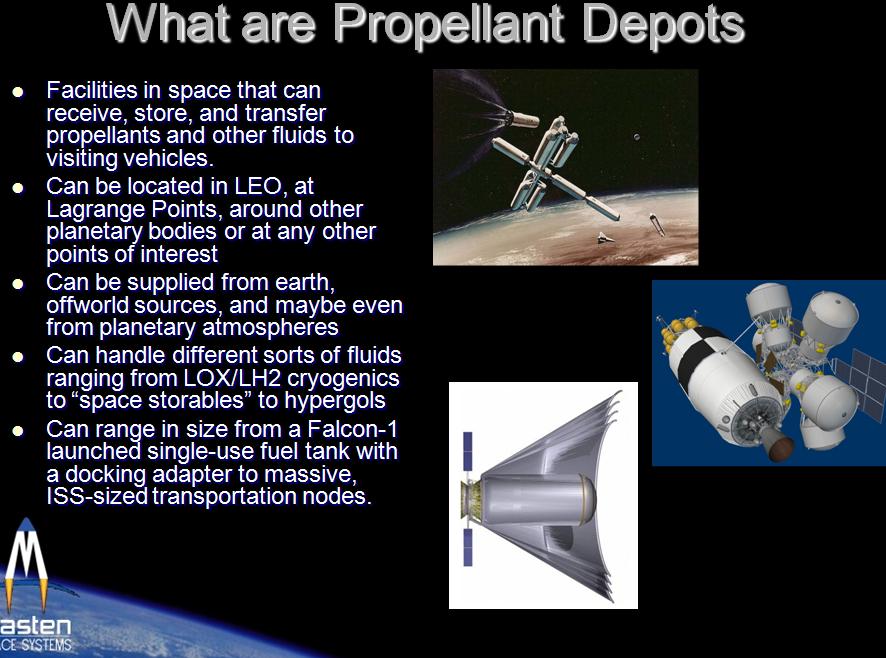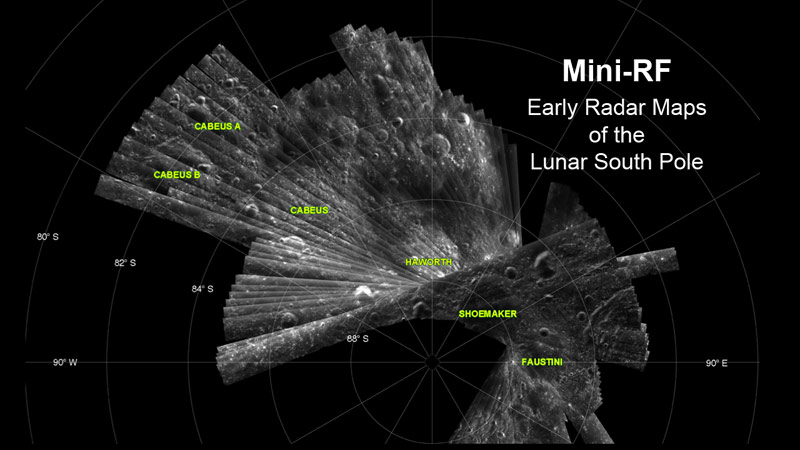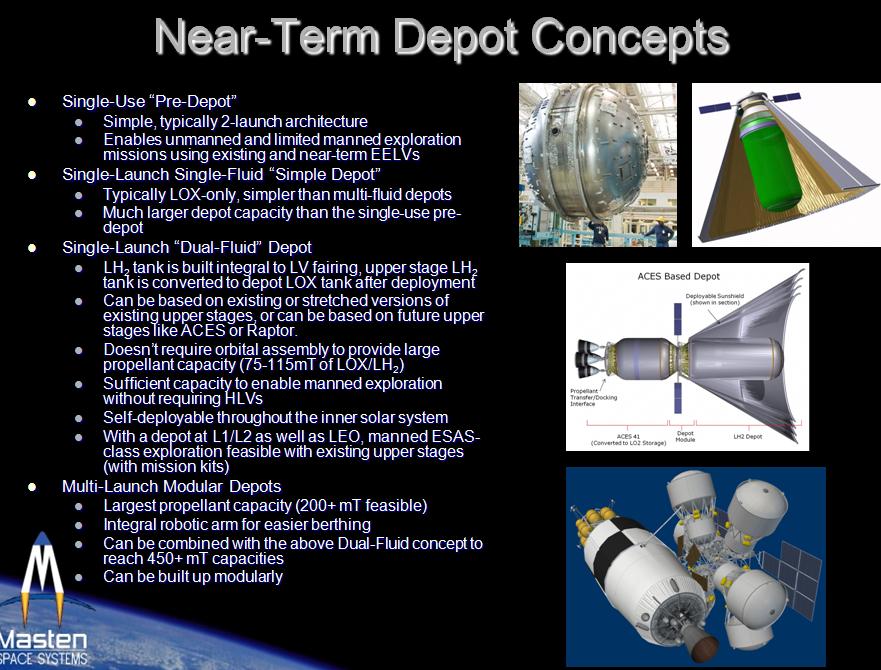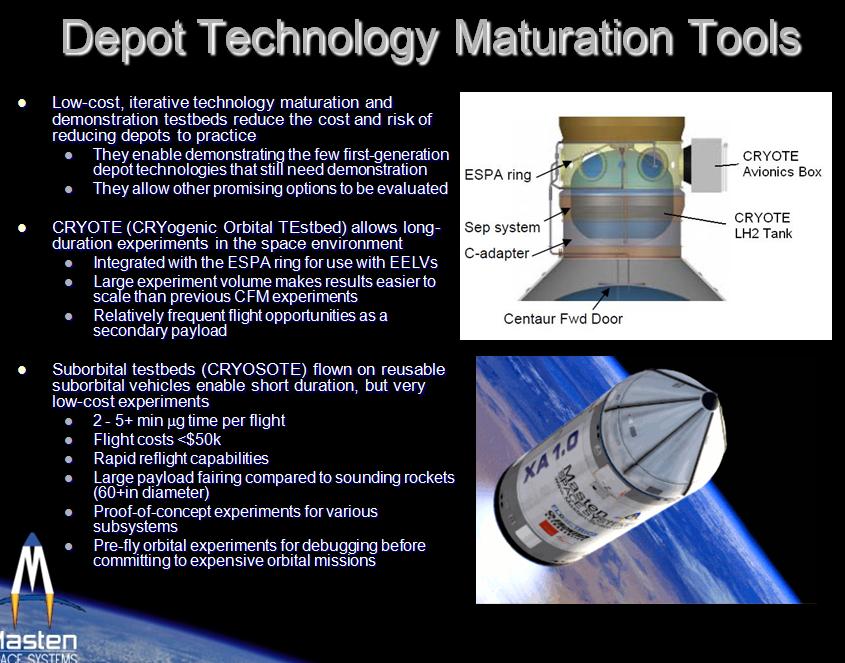|
Lunar Water |
||||
|
Water Around a Fresh Crater 09.24.2009 ..
These images show a very young lunar crater on the side of the moon that faces away from Earth, as viewed by NASA's Moon Mineralogy Mapper on the Indian Space Research Organization's Chandrayaan-1 spacecraft. On the left is an image showing brightness at shorter infrared wavelengths. On the right, the distribution of water-rich minerals (light blue) is shown around a small crater. Both water- and hydroxyl-rich materials were found to be associated with material ejected from the crater. Credits: ISRO/NASA/JPL-Caltech/USGS/Brown Univ. SOURCE: NASA Water on the Moon |
||||
Related Links:
|
||||
| NASA To Reveal New Scientific
Findings About The Moon
Sept. 22, 2009 Dwayne Brown
MEDIA ADVISORY: M09-183
WASHINGTON -- NASA will hold a media briefing at 2 p.m. EDT on Thursday, Sept. 24, to discuss new science data from the moon collected during national and international space missions. NASA Television and the agency's Web site will provide live coverage of the briefing from the James E. Webb Memorial Auditorium at NASA Headquarters, 300 E St. SW, in Washington. The briefing participants are:
Papers supporting the briefing will be published online by the journal Science at its Science Express Web site. Science will lift its embargo at 2 p.m. EDT, Sept. 24. -end- SOURCE: NASA News Briefing |
||||
|
Shows A Lot of Water on the Moon ..
NASA Expected to Reveal Moon
Mineral Mapper Shows A Lot of Water on the Moon
Water on the moon should be used to supply fuel for fuel depots in space to enable colonization and lower cost access to space. Reliable sources report that there will be a press conference at NASA HQ at 2:00 pm this Thursday featuring lunar scientist Carle Pieters from Brown University. UPDATE: NASA
and Science Journal Information and Pictures
The topic of the press briefing will be a paper that will appear in this week's issue of Science magazine wherein results from the Moon Mineralogy Mapper (M3) aboard Chandrayaan-1 will be revealed. The take home message: there is a lot of water on the Moon. Stay tuned. (H/T Transterrestrial) Water can exist at the lunar poles in the form of ice and could exist further underground in other locations. We will find out on Thursday on the particulars. Source: NASA Watch UPDATE: From Spaceref: Three articles will appear in Science Magazine Sept 24, 2009 - one paper each describing results on lunar observations from three spacecraft: Deep Impact aka EPOXI, Cassini, and Chandrayaan-1. Three different spacecraft - three different instruments - all saying the same thing about the presence of water and other materials on the Moon. The EPOXI paper says that water has been "unequivocally" confirmed and that "the entire lunar surface is hydrated during at least some portions of the lunar day".SOURCE: Spaceref Space.com has coverage of the new moon water science.
Nature News says: “Results soon to be published… will show detailed spectra confirming that, indeed, the polar regions of the moon are chockfull of water-altered minerals.” Two impacts are planned October 9 around 7:30 a.m. Eastern time in the region of a crater called Cabeus-A near the Moon's south pole.Some of the water comes and goes during the lunar day. It's not a lot of water. If you took a two-liter soda bottle of lunar dirt, there would probably be a medicine dropperful of water in it, said University of Maryland astronomer Jessica Sunshine, one of the scientists who discovered the water. Another way to think of it is if you want a drink of water, it would take a baseball diamond's worth of dirt, said team leader Carle Pieters of Brown University. "It's sort of just sticking on the surface," Sunshine said. "We always think of the moon as dead and this is sort of a dynamic process that's going on." More interesting, the amount of absorption — and thus the quantity of water — varied over time. That suggests the water is being created when protons from the solar wind slam into the lunar surface. The collisions may free oxygen atoms in the minerals and allow them to recombine with protons and electrons to form water.
SOURCE: http://m3.jpl.nasa.gov/ Fuel Depot Papers Orbital cryogenic propellant depots and the ability to refuel spacecraft in orbit are critical capabilities for the expansion of human life throughout the Solar System. While depots have long been recognized as an important component of large-scale manned spaceflight efforts, questions about their technology readiness have so far prevented their implementation. Technological advancements in settled cryogenic handling, passive thermal control systems, and autonomous rendezvous and docking techniques make near-term implementation of cryogenic propellant depots significantly more realistic. Current work on flight-demonstration tools like ULA’s CRYOTE testbed, and Masten Space Systems’s XA-1.0 suborbital RLV provide methods for affordably retiring the remaining technical risks for cryogenic depots.11 page powerpoint presentation on fuel depots in space
|
||||
| It's not
lunacy, probes find water in moon dirt
By SETH BORENSTEIN (AP) Sept. 23, 2009 WASHINGTON — The moon isn't the dry dull place it seems. Traces of water lurk in the dirt unseen. Three different space probes found the chemical signature of water all over the moon's surface, surprising the scientists who at first doubted the unexpected measurement until it was confirmed independently and repeatedly. It's not enough moisture to foster homegrown life on the moon. But if processed in mass quantities, it might provide resources — drinking water and rocket fuel — for future moon-dwellers, scientists say. The water comes and goes during the lunar day. It's not a lot of water. If you took a two-liter soda bottle of lunar dirt, there would probably be a medicine dropperful of water in it, said University of Maryland astronomer Jessica Sunshine, one of the scientists who discovered the water. Another way to think of it is if you want a drink of water, it would take a baseball diamond's worth of dirt, said team leader Carle Pieters of Brown University. "It's sort of just sticking on the surface," Sunshine said. "We always think of the moon as dead and this is sort of a dynamic process that's going on." The discovery, with three studies bring published in the journal Science on Thursday and a NASA briefing, could refocus interest in the moon. The appeal of the moon waned after astronauts visited 40 years ago and called it "magnificent desolation." The announcement comes two weeks before a NASA probe purposely smashes near the moon's south pole to see if it can kick up buried ice. Over the last decade, astronomers have found some signs of underground ice on the moon's poles. But this latest discovery is quite different. It finds unexpected and pervasive water clinging to the surface of soil, not absorbed into it. "It is drier than any desert we have here," Sunshine said. The water was spotted by spacecraft that either circled the moon or flew by. All three ships used the same type of instrument that looked at the absorption of a specific wavelength of light that is the chemical signature of only two molecules: water and hydroxyl. Hydroxyl is one atom of hydrogen with one atom of oxygen, instead of two hydrogen atoms in water. Because of the timing during the daylight when some of that wavelength disappears and some doesn't, it shows that both hydroxyl and water are present, Sunshine said. This light wavelength was first discovered by an instrument on the Indian lunar satellite Chandrayaan-1, which stopped operating last month. Scientists initially figured something was wrong with the instrument because everyone knew the moon did not have a drop of water on the surface, Pieters said. "We argued literally for months amongst ourselves to find out where the problem was," Pieters said. Sunshine, who was on the team, had a similar instrument on NASA's Deep Impact probe, headed for a comet but swinging by the moon in June. So Deep Impact looked for the water-hydroxyl signature — and found it. Scientists also looked back at the records of NASA's Cassini probe, which is circling Saturn. It has the same type instrument and whizzed by the moon ten years ago. Sure enough, it had found the same thing. The chance that three different instruments malfunctioned in the same way on three different spaceships is almost zilch, so this confirms that it's water and hydroxyl, Pieters said. "There's just no question that it's there," Pieters said. "It's unequivocal." Scientists testing lunar samples returned to Earth by astronauts did find traces of water, but they had figured it was contamination from moisture in Earth air, Pieters said. Three scientists who were not part of the team of discoverers said the conclusion makes sense, with Arizona State University's Ron Greeley using the same word as Pieters: unequivocal. Lunar and Planetary Institute senior scientist Paul Spudis called it exciting and said it raises the logical question: Where did that water come from? Pieters figures there are three possibilities: It came from comets or asteroids that crashed into the moon, those crashes freed up trapped water from below the surface, or the solar wind carries hydrogen atoms that binds with oxygen in the dirt. That final possibility is the one that Sunshine and Pieters both prefer. If it is the solar wind, that also means that other places without atmosphere in our solar system, such as Mercury or asteroids, can also have bits of water, Sunshine said. SOURCE: Associated Press |
||||
| FAIR USE NOTICE: This page contains copyrighted material the use of which has not been specifically authorized by the copyright owner. Pegasus Research Consortium distributes this material without profit to those who have expressed a prior interest in receiving the included information for research and educational purposes. We believe this constitutes a fair use of any such copyrighted material as provided for in 17 U.S.C § 107. If you wish to use copyrighted material from this site for purposes of your own that go beyond fair use, you must obtain permission from the copyright owner. | ||||
|
|
